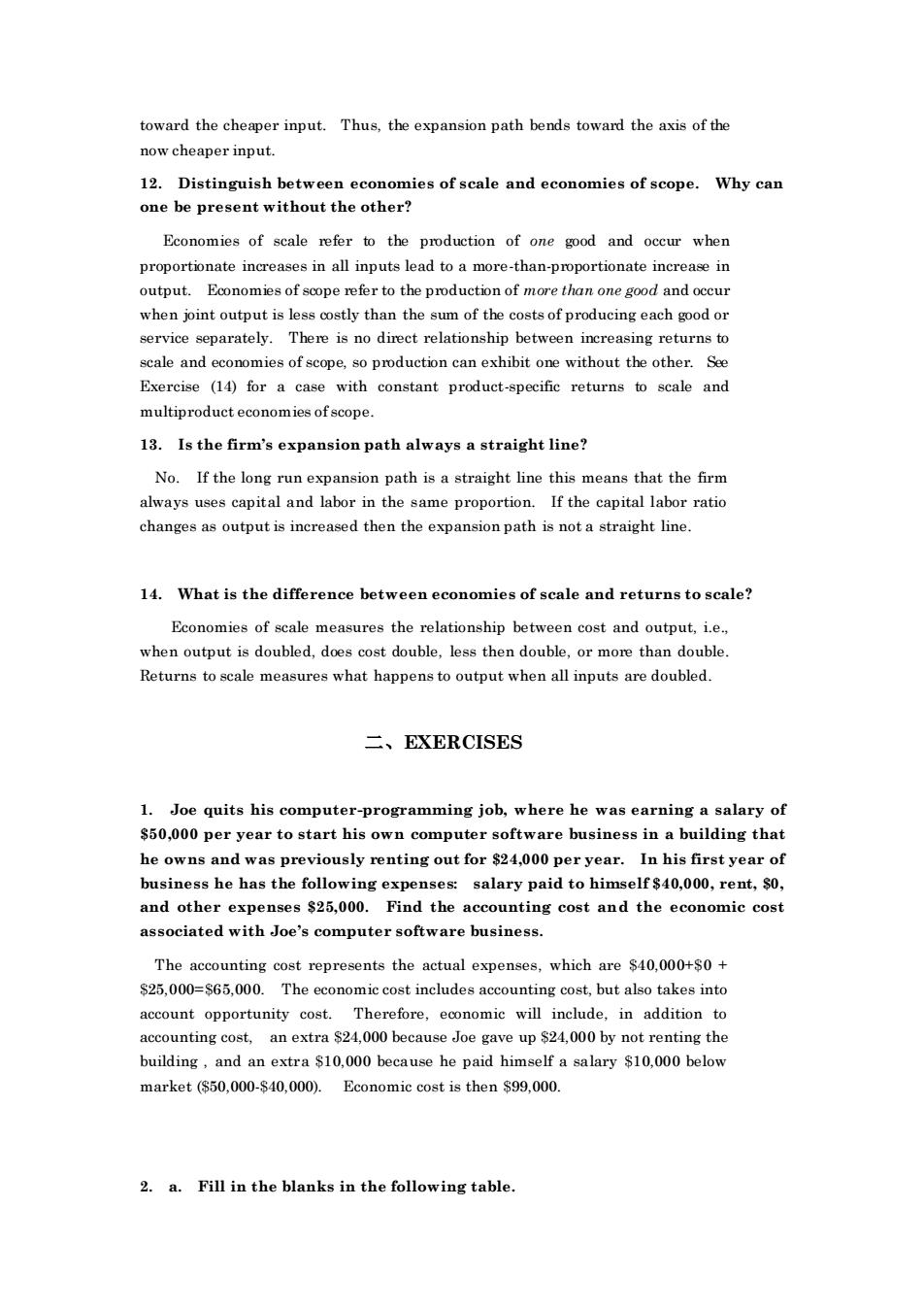正在加载图片...

toward the cheaper input.Thus,the expansion path bends toward the axis of the now cheaper input 12.Distinguish betwee one be present without the other? Economies of scale refer to the production of one good and occur when proportionate increases in all inputs lead to a more-than-proportionate increase in output.Eoonomies of scope refer to the production of more than one good and occur each good or e etw g re scale and economies of scope,so production can exhibit one without the other.S Exercise (14)for a case with constant product-specific returns to scale and multiproduct economies of scope. 13.Is the firm's expansion path always a straight line? No.If the long run expansion path is a straight line this means that the firm always uses capital and labor in the same proportion.If the capital labor ratio ehanges as output is increased then the expansion path is not a straight line. 14.What is the difference between economies of scale and returns to scale? Economies of scale measures the relationship between cost and output,i.e when output is doubled,does cost double,less then double.or more than double Returns to scale measures what happens to output when all inputs are doubled. 二、EXERCISES 1.Joe quits his computer-programming job,where he was earning a salary of $50,000 per year to start his own computer software business in a building that he owns and was previously renting out for 00 peryear. In his first year of busine ess he has the following expense salary paid to himself$40,000,rent,$ and other expenses $25,000.Find the accounting cost and the economic cost associated with Joe's computer software business. The accounting cost represents the actual expenses.which are S40.000+S0+ S25.000=S65.000.The economic cost includes accounting cost.but also takes into account oppo ing co an extra $24.000 be Joe ga ep24.000wn0 renting th building,and an extra $10.000 because he paid himself a salary $10.000 below market ($50,000-$40,000).Economic cost is then $99,000. 2.a.Fill in the blanks in the following table.toward the cheaper input. Thus, the expansion path bends toward the axis of the now cheaper input. 12. Distinguish between economies of scale and economies of scope. Why can one be present without the other? Economies of scale refer to the production of one good and occur when proportionate increases in all inputs lead to a more-than-proportionate increase in output. Economies of scope refer to the production of more than one good and occur when joint output is less costly than the sum of the costs of producing each good or service separately. There is no direct relationship between increasing returns to scale and economies of scope, so production can exhibit one without the other. See Exercise (14) for a case with constant product-specific returns to scale and multiproduct economies of scope. 13. Is the firm’s expansion path always a straight line? No. If the long run expansion path is a straight line this means that the firm always uses capital and labor in the same proportion. If the capital labor ratio changes as output is increased then the expansion path is not a straight line. 14. What is the difference between economies of scale and returns to scale? Economies of scale measures the relationship between cost and output, i.e., when output is doubled, does cost double, less then double, or more than double. Returns to scale measures what happens to output when all inputs are doubled. 二、EXERCISES 1. Joe quits his computer-programming job, where he was earning a salary of $50,000 per year to start his own computer software business in a building that he owns and was previously renting out for $24,000 per year. In his first year of business he has the following expenses: salary paid to himself $40,000, rent, $0, and other expenses $25,000. Find the accounting cost and the economic cost associated with Joe’s computer software business. The accounting cost represents the actual expenses, which are $40,000+$0 + $25,000=$65,000. The economic cost includes accounting cost, but also takes into account opportunity cost. Therefore, economic will include, in addition to accounting cost, an extra $24,000 because Joe gave up $24,000 by not renting the building , and an extra $10,000 because he paid himself a salary $10,000 below market ($50,000-$40,000). Economic cost is then $99,000. 2. a. Fill in the blanks in the following table